Introduction
- Diabetic ketoacidosis (DKA) is a life-threatening emergency
- Requires prompt diagnosis and treatment
- Characterised by hyperglycaemia, metabolic acidosis and ketonaemia
- DKA occurs mostly in type 1 diabetes
Causes/Precipitating Factors
- Lack of insulin e.g. non-compliance, undiagnosed diabetes
- Drugs e.g. some antipsychotics, corticosteroids, thiazide diuretics, sodium-glucose co-transporter-2 (SGLT2) inhibitors
- Infection e.g. urinary tract infection, pneumonia
- Myocardial infarction
- Stroke
- Illicit drug use e.g. cocaine
- Alcohol
Symptoms and Signs of DKA
- Lethargy
- Abdominal pain
- Dehydration
- Polydipsia
- Polyuria
- Ketones on breath (smell of pear drops)
- Kussmaul respiration (deep and rapid breathing)
- Tachycardia
- Vomiting
- Weight loss
Note: clinical presentation varies with the severity of DKA and the presence of comorbid condition(s)
Diagnosis of DKA
- Ketonaemia ≥ 3.0mmol/L or significant ketonuria (more than 2+ on standard urine sticks)
- Blood glucose > 11.0mmol/L or known diabetes mellitis
- Bicarbonate (HCO3–) < 15.0mmol/L and/or venous pH < 7.3
Source: Joint British Diabetes Societies Inpatient Care Group. The management of diabetic ketoacidosis in adults. 2nd ed. London: Joint British Diabetes Societies Inpatient Care Group for NHS Diabetes, 2013.
Management
- Hospital protocol/guideline followed
- Involves: Insulin administration and replacement of fluid and electrolytes
Complications of DKA
- Hypokalaemia and hyperkalaemia
- Hypoglycaemia
- Cerebral oedema
- Pulmonary oedema
Prevention of DKA
- Patient education on: recognising signs and symptoms of DKA, possible risk factors for DKA, sick day rules, how to monitor blood glucose and ketone levels, the importance of medication compliance
Further DKA Clinical Resources
The management of diabetic ketoacidosis in adults
This comprehensive guideline from the Joint British Diabetes Societies (JBDS) on the management of DKA provides a detailed DKA pathway of care that is clear and easy to follow.
The guideline also addresses best practice for DKA and the complications of DKA.
To read the full guideline, click here.
MHRA Update: Risk of DKA with SGLT2 inhibitors
In this drug safety update from MHRA, healthcare professionals are warned about the risk of DKA with SGLT2 inhibitors (canagliflozin, dapagliflozin, or empagliflozin). It also gives guidance to healthcare professionals who are treating patients taking SGTLT2 inhibitors
To read the full update, click here.



